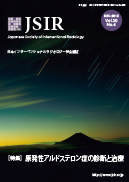30 巻, 4 号
選択された号の論文の9件中1~9を表示しています
- |<
- <
- 1
- >
- >|
特集
原発性アルドステロン症の診断と治療
-
2015 年 30 巻 4 号 p. 317-324
発行日: 2015年
公開日: 2016/09/07
PDF形式でダウンロード (4603K) -
2015 年 30 巻 4 号 p. 325-330
発行日: 2015年
公開日: 2016/09/07
PDF形式でダウンロード (1366K) -
2015 年 30 巻 4 号 p. 331-337
発行日: 2015年
公開日: 2016/09/07
PDF形式でダウンロード (1240K) -
2015 年 30 巻 4 号 p. 338-344
発行日: 2015年
公開日: 2016/09/07
PDF形式でダウンロード (2459K)
症例報告
-
2015 年 30 巻 4 号 p. 345-348
発行日: 2015年
公開日: 2016/09/07
PDF形式でダウンロード (1018K) -
2015 年 30 巻 4 号 p. 349-353
発行日: 2015年
公開日: 2016/09/07
PDF形式でダウンロード (1326K)
第43回日本IVR学会総会「技術教育セミナー」より
放射線防護
-
2015 年 30 巻 4 号 p. 354-356
発行日: 2015年
公開日: 2016/09/07
PDF形式でダウンロード (658K) -
2015 年 30 巻 4 号 p. 357-360
発行日: 2015年
公開日: 2016/09/07
PDF形式でダウンロード (1002K) -
2015 年 30 巻 4 号 p. 361-367
発行日: 2015年
公開日: 2016/09/07
PDF形式でダウンロード (1924K)
- |<
- <
- 1
- >
- >|
